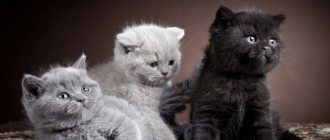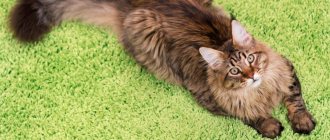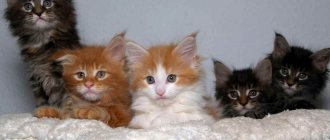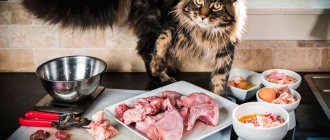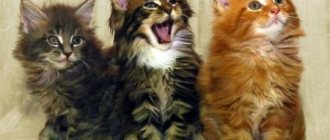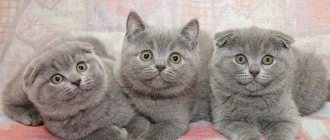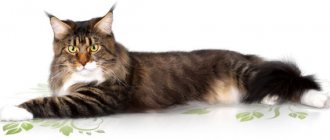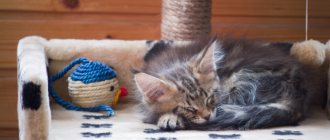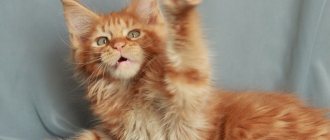Everyone knows how difficult it is to bathe cats, especially large cats like Maine Coons. However, their long, showy coat requires careful and regular grooming. We'll tell you how to properly wash a Maine Coon, how often it should be done and what products to use to make your pet look chic and well-groomed.
How often to bathe a Maine Coon
There is an opinion that cats should not be washed at all, since bathing washes away their natural oil layer from their fur and skin. Baths are allowed only in exceptional cases: when the animal gets dirty on the street, in the apartment during repairs or accidents. Despite the fact that cats have their own way of washing themselves by licking their tongues, and water procedures are a stressful event for them, periodic washing is necessary for them.
Experienced breeders and groomers believe that a Maine Coon should be bathed at least once every 1-2 months. During this time, many dust particles settle on the fatty layer covering the fur, which disrupts air exchange and makes it difficult for new hair to grow. The long fur of Maine Coons will fall apart into strands, look untidy and greasy, tangles will form on the fur, and combing them out is quite problematic; it’s easier to cut them off.
If the cat regularly attends exhibitions, you need to bathe him even more often: at least once a week, a few days before the exhibition. It is recommended to bathe your pet during shedding and when soiled.
Particular attention should be paid to the tail: in Maine Coons it tends to quickly become greasy, starting from 4 months, and in cats to a greater extent than in cats.
In addition to regular bathing, Maine Coons must be constantly combed at least once every 2 weeks with different types of combs:
- downy for undercoat;
- a brush with teeth of different levels;
- a fine comb for the hair on the paws.
SIGNS OF A HEALTHY ANIMAL
A healthy Maine Coon is always active and cheerful. He should have a good appetite, even breathing, his nose is always slightly moist and clean. A healthy animal carefully monitors its appearance, constantly licks itself, and has regular bowel movements and urination.
In order to properly monitor the health of your pet, you need to know what the normal body temperature is, as well as other physiological indicators of cats. Remember that in healthy animals the temperature fluctuates between 37.5 - 39 ° C, pulse 110 - 130 beats per minute, breathing - 16 - 30 respiratory movements per minute.
If your pet is sick, he becomes apathetic, lethargic and inactive. The animal often hides in a corner of the room and lies there, preferring not to move, does not respond to its name, and does not go out to its favorite treat. It tries not to move at all, rises from its place reluctantly, and sometimes groans. His nose is dry and often hot, his mouth has an unpleasant odor, his eyes are watery, his appetite is reduced or absent altogether.
Further development depends on the clinical picture of the disease. For example, there may be an increase in temperature by 1 - 2 °C, animals experience shortness of breath, pulse and breathing become more frequent. Thus, the diagnosis can often be made based on the animal's appearance. To clarify it, parts of the animal’s body (ears, eyes, fur) are examined.
To clarify the diagnosis, laboratory tests (helminthological, bacteriological, etc.) play an important role. At the same time, samples for analysis often have to be taken by cat owners themselves, on the advice or under the guidance of a veterinary specialist. Remember that a correct and timely diagnosis determines the effectiveness of further treatment.
Preparation for water procedures
Maine Coons, like other cats, do not particularly like to bathe or splash in water. But since long hair requires frequent washing, it is recommended to accustom them to bathing from childhood: this way they will be able to endure a stressful procedure easier and more calmly. The first rule of bathing is to avoid drafts and open doors to avoid colds and illnesses. The pet can be washed in a regular bathtub or basin with a 10 cm layer of water, watering it from a shower head. It is advisable to lay a terry towel or boards on the floor so that the cat can cling to them with its claws to calm itself.
Try to prepare the necessary equipment in advance so that you don’t rush around the room looking for what you need and don’t run out of it. It is recommended that two people bathe the Maine Coon: one holds the cat, the other carries out the washing procedures. If you don’t have an assistant, you can use a harness by tying its free end to a hook on the wall in the bathroom. The water temperature should be no more than 37-37.5C: there is no need to give your cat a steam bath.
For professional grooming, it is recommended to use detergents for Maine Coons, preferably from one professional line:
- degreaser: Jerob cream, Groomer's Goop paste or gel;
- shampoo for Maine Coon: for long or medium coat, for example, IV San Bernard;
- tint shampoo for coloring;
- texturizer and conditioner.
Regular human soap and shampoos are not recommended. All means must be placed at hand, but not within the cat’s reach, otherwise he may turn everything over with his paws if he starts to get nervous. Before washing, you should prepare paper and terry towels.
Before you wash your Maine Coon, you need to prepare it:
- trim the claws on the front and hind paws;
- check for small wounds;
- clean your ears;
- It is good to comb out the hair from tangles on the chest, collar, belly and trousers, and you need to treat the tail especially carefully: the guard hairs on it are easily combed out, but subsequently grow back for a long time.
MEASURING TEMPERATURE IN A CAT
Before you begin this procedure, prepare all the necessary equipment: a rectal thermometer, lubricant, paper towels, alcohol, a watch, and a large towel or strong cloth in which you will wrap your pet.
Gently shake the thermometer and coat the tip with Vaseline. Next, take a large towel and wrap your cat in it, making sure to securely wrap it around her body and neck. Then lift the cat's tail and insert the tip of the thermometer into the rectum. Try to insert gently but firmly enough. Insert the thermometer directly into the center of the anus. Do not insert the thermometer too deeply - it should go no more than 2 cm inside, so you only need to insert the thermometer ball.
Leave the thermometer in the animal's rectum for 2 minutes. Then slowly take it out, dry it gently with a paper towel, being careful not to break it, and check the temperature on it. The normal body temperature of a Maine Coon ranges between 38.2 – 38.9 °C. Sometimes there may be some natural temperature fluctuations.
Once you have determined your cat's body temperature, carefully record the measurement. Then wipe the thermometer with alcohol and put it away in the designated place. Before letting your cat go, pet it, call it by name, talk to it gently for a few minutes - this will calm the animal.
How to bathe a Maine Coon correctly: stages of the procedure
- Degreasing. First, apply a degreasing cream to the cat’s dry fur and rub it thoroughly, leaving it for an average of 5 minutes, and then rinse with warm water. It's necessary:
- to remove the fat layer on the coat, otherwise it will look dirty after bathing;
- thoroughly wet the Maine Coon's outer coat, which is water-repellent.
- Wash off the paste with warm water and apply shampoo, first foaming it in your hands, and then distributing it from head to tail in the direction of hair growth. The head can also be wetted and gently treated with shampoo, but the ears should not be wetted. To prevent water from getting into your ears, fold them in half from the edges to the center. Rinse off the shampoo thoroughly.
- Next, if desired, you can apply coloring shampoo. It is clear that for white-haired cats it will be one thing, but for blue, red or black cats it will be completely different.
- The final step is to apply conditioner to close the cuticle of the fur hairs. We wash it off especially carefully, using slightly cooler water than when washing off shampoo.
The bathing procedure is simple, the main thing is not to be nervous yourself and constantly talk to your pet in a gentle, confident voice, avoiding screams, sudden sounds and movements, such as hitting the water or falling objects. We ignore the Maine Coon’s bad behavior during bathing, don’t yell at him, and always reward good behavior.
Drying and combing wool
Immediately after bathing, the cat should be wrapped and blotted with a towel, never rubbing the fur. To remove water, as a rule, one towel is not enough: first you will need a paper one, and then at least two terry ones. You can even swaddle the cat in a towel and hold it in your arms for 5-6 minutes, then carefully comb it, unraveling and combing out tangles if possible, or, in extreme cases, cutting them out with scissors.
You need to dry your cat at home naturally or with a hairdryer. The hairdryer is especially recommended for grooming before a show. Therefore, if you plan to regularly visit exhibitions, get your future champion used to using a hair dryer, although cats don’t really like it because of its buzzing and hissing. Blow-drying, like washing, is easiest done by two people: one combs the wool in the opposite direction of its growth, and the other directs a stream of air. The Maine Coon should be dried with a hairdryer or regular combing until completely dry. If not dried thoroughly, the fur may curl up and hang in strands. In this case, the hair in the damaged area must be wetted again and dried properly.
If you have difficulty bathing your Maine Coon, drying its fur with a hairdryer, and you are afraid that you will not be able to cope with this procedure due to the particularly large size of your pet, we recommend watching a video on this topic.
Suitable Shampoo
When choosing a shampoo, you should choose the liquid version, which is most suitable for a long-haired cat. It will do an excellent job of removing dirt from your pet’s fur, as well as improving its appearance and strengthening its structure.
Areas with dense fur need to be given more attention. It is important to use shampoo designed specifically for bathing cats with long hair. Under no circumstances should you use soap or regular shampoo.
When not to wash your pet
Bathing for an animal is always a strong stress to which its immune system is quite sensitive. Stress is also caused by moving to another house, staying at an exhibition, changing the usual environment, food, the appearance of noisy guests or other pets. Therefore, bathing a cat in such situations is not recommended. There are also a number of special contraindications for washing an animal:
- during any illness;
- being in quarantine;
- before vaccination.
There is no need to immediately bathe the kitten after you bring it to your home. Such bathing can only be harmful to the baby’s health.
Whether a Maine Coon needs to be washed periodically or not, and how often to do it, is up to each owner to decide for himself. But you must admit, it’s nice when a clean and good-smelling cat walks around the house, and not a ball of fur hung with icicles with a shiny tail. When choosing a cleaning product, use only special shampoos, creams and sprays for grooming, taking into account the age, gender and color of the animal. It is also necessary to select funds experimentally. If, despite regular water treatments, the coat quickly loses its grooming and shine, perhaps the Maine Coon should be shown to a veterinarian. And remember: bathing for a mustachioed pet is not the most pleasant procedure, but is always stressful. Therefore, do not try to overdo it in the pursuit of cleanliness and beauty; think first of all about your pet’s health and well-being.
DETERMINING A CAT'S BREATHING RATE
The cat's breathing rate can be determined by counting the number of inhalations and exhalations within 1 minute. To do this, they use different techniques: they determine breathing by the movement of the chest, or you can put your palm on the cat’s chest, which will make it possible to feel and count the number of respiratory movements. The normal number of inhalations and exhalations in a healthy Maine Coon ranges from 16 to 30 per minute.
The breathing rate depends on a number of factors that should be taken into account. Remember, kittens breathe more often than adult animals, as they have a more active metabolism. Cats breathe more frequently than cats. Pregnant or nursing cats breathe a little faster than usual. Small cats breathe more often than large ones. The breathing process is also affected by the time of day and season.
An increased number of respiratory movements in a cat can be considered a deviation from the norm if it cannot be explained by any of the above reasons.
Documentation
Before purchasing a Maine Coon, the breeder is required to provide the buyer with the following documents:
- Veterinary passport of the animal with all vaccinations;
- A purchase and sale agreement, which specifies the terms of purchase and is drawn up according to the rules of felinological systems;
- Pedigree;
- A certificate or document indicating the rules for caring for the kitten;
- Pedigrees and confirmation of parents' titles;
- Registration in felinological systems (desirable).
If the breeder refuses to provide the documents described above, then you should not purchase an animal from him.
A professional breeder will tell you all the necessary information before purchasing, but find out a few nuances:
- Find out what food the kitten ate;
- What filler does the specialist use? This will help the kitten get used to the new place and determine where exactly to go to the toilet;
- Get information regarding your Maine Coon's health, character and habits.
Maine Coons are smart, loyal and incredibly beautiful cats that will become not just a pet, but a full-fledged member of the family.
Scratching posts
A scratching post is necessary not only to protect furniture from damage, but also to maintain the health of your pet. Too long nails can cause curled nails, discomfort when walking and, as a result, lameness, sprained ligaments, painful cracks and chipped nails. Scratching posts can be:
- wall - planks covered with sisal rope or canvas;
- floor - sisal rugs lying on the floor;
- free-standing - posts wrapped in sisal rope and standing on a wide, round base.
It is believed that wall-mounted scratching posts and posts are better for coons.
How to train?
After the cat wakes up, you need to pick him up and take him to the scratching post. First, he should sniff it and calm down, then, supporting the pet, you should run the pads of his paws along the scratching post. This needs to be repeated several times, then praise and pet the pet.
Types of cat houses
The range of cat houses in stores is quite large; it can be difficult for an inexperienced coon owner to choose the right option for his pet. It could be:
- a hammock that can be secured on 4 sides almost anywhere, even under a chair;
- a house in the form of a booth, which is a fabric-upholstered structure with a roof;
- cardboard house of any kind - such products look original, but are not practical.
Also popular are smaller copies of home furniture - beds and sofas for cats.
Beds
One of the simplest options for a cat house. Essentially, it is a thick mattress covered with fabric that can be removed and washed if necessary. Beds can be round, square, rectangular, heart-shaped, etc. It is important that the size of the bed matches the size of an adult cat.
Carrying
There are several types of carriers:
- bag - a carrier made of lightweight fabric with a frame, thick walls and a mesh that allows air to pass through, some models are equipped with small windows;
- a backpack is the most convenient option for travelers, since the owner’s hands remain free;
- plastic container - a stable, ventilated design that is easy to clean;
- cage – designed for transporting cats in transport and is a stable, durable, well-ventilated metal structure.
It is best to have several types of carriers, since each of them is convenient for some purposes and not for others.
Game complexes
These are three-dimensional structures that include everything that a Maine Coon needs for a comfortable life and development: loopholes, stairs, hammocks, a house, scratching posts, toys, etc. Play complexes are a good way to provide your pet with everything necessary and organize his leisure time, but you should understand that they take up a lot of space and are not suitable for installation in a small apartment.
Vaccinations
The first vaccination is given when the kitten is 2 months old. A complex vaccine is used that protects against rhinotracheitis, panleukopenia, calicivirus infection and chlamydia. The second vaccination is given at 3 months, and at the same time the pet is vaccinated against rabies. Subsequently, vaccination is carried out at 1 year of age and annually thereafter.
10 - 14 days before vaccination it is necessary to carry out deworming.
